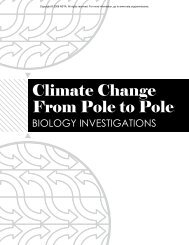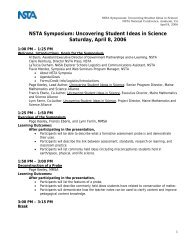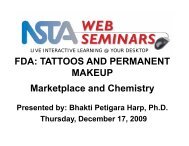Science Anxiety: Research and Action - NSTA Learning Center ...
Science Anxiety: Research and Action - NSTA Learning Center ...
Science Anxiety: Research and Action - NSTA Learning Center ...
Create successful ePaper yourself
Turn your PDF publications into a flip-book with our unique Google optimized e-Paper software.
HANDBOOK OF COLLEGE SCIENCE TEACHING<br />
<strong>Science</strong> <strong>Anxiety</strong>: <strong>Research</strong> <strong>and</strong> <strong>Action</strong><br />
5. “Catch students doing something right!” (Fuller et al. 1985). The version of this approach<br />
that I have found effective is to stay with the student who has been questioned, work<br />
backward through Socratic dialogue until the student reaches the last concept that he or<br />
she understood, <strong>and</strong> then move forward to eliciting the right answer.<br />
6. Gender-equitable laboratory practice. Most science teachers have observed male students’<br />
eagerness to play with (<strong>and</strong> break) equipment, contrasted with females’ anxiety about<br />
doing the same. The remedy is careful monitoring of laboratory group practice, to make<br />
sure that groups are not divided into scientists <strong>and</strong> secretaries.<br />
7. Balancing content <strong>and</strong> relationship in teacher-student interactions. The AAPT workshop<br />
(Fuller et al. 1985) focuses on four aspects of teaching:<br />
1. the classroom learning environment,<br />
2. information transfer between teacher <strong>and</strong> student,<br />
3. teacher-student interaction, <strong>and</strong><br />
4. teachers’ evaluations of student performance.<br />
The learning environment includes body language, tone of voice, word selection,<br />
<strong>and</strong> classroom organization by the teacher. Information transfer deals with all aspects<br />
of content, from course ground rules to teaching techniques, <strong>and</strong> how these can affect<br />
student confidence. Teacher-student interaction focuses primarily on the technique<br />
known as active listening, helping teachers modify their listening styles so that they hear<br />
the student’s whole agenda, not simply the one he or she presents. Even such subtle but<br />
critical items as placement of chairs in the teacher’s office are important. Finally, evaluation<br />
of student performance deals not only with fair <strong>and</strong> effective grading but also with<br />
the nature of comments on papers <strong>and</strong> tests <strong>and</strong> how these comments can diminish or<br />
enhance student confidence.<br />
The workshop also deals specifically with issues of females <strong>and</strong> underrepresented<br />
minorities in the science classroom. Workshop “graduates” are then expected to bring<br />
these techniques not only to their own classrooms but to their colleagues as well. As<br />
noted earlier, I have used the workshop materials for binational comparison studies of<br />
teachers’ styles in the United States <strong>and</strong> Denmark (Mallow 1995). Several hundred teachers<br />
in at least two countries have benefited from training in science anxiety reduction.<br />
The workshop manual is available from AAPT.<br />
8. Explicit focus on metacognition. Effective learning has been shown to be highly correlated<br />
with the use of metacognitive or self-regulatory skills (Beyer 1992). Monitoring “how we<br />
learn what we learn” can lower students’ anxieties in the classroom, while providing a<br />
unique way for students to process the material they are learning. This “stepping back”<br />
helps demystify the learning of science <strong>and</strong> undercuts the myth that there is a special,<br />
rare, <strong>and</strong> unteachable talent needed for doing so.<br />
9. Response to the wide variety of student learning styles. This practice encompasses many of<br />
the other recommendations. The more multimodal the classroom—lecture, demonstra-<br />
Copyright © 2006 by the National <strong>Science</strong> Teachers Association.<br />
1<br />
9







